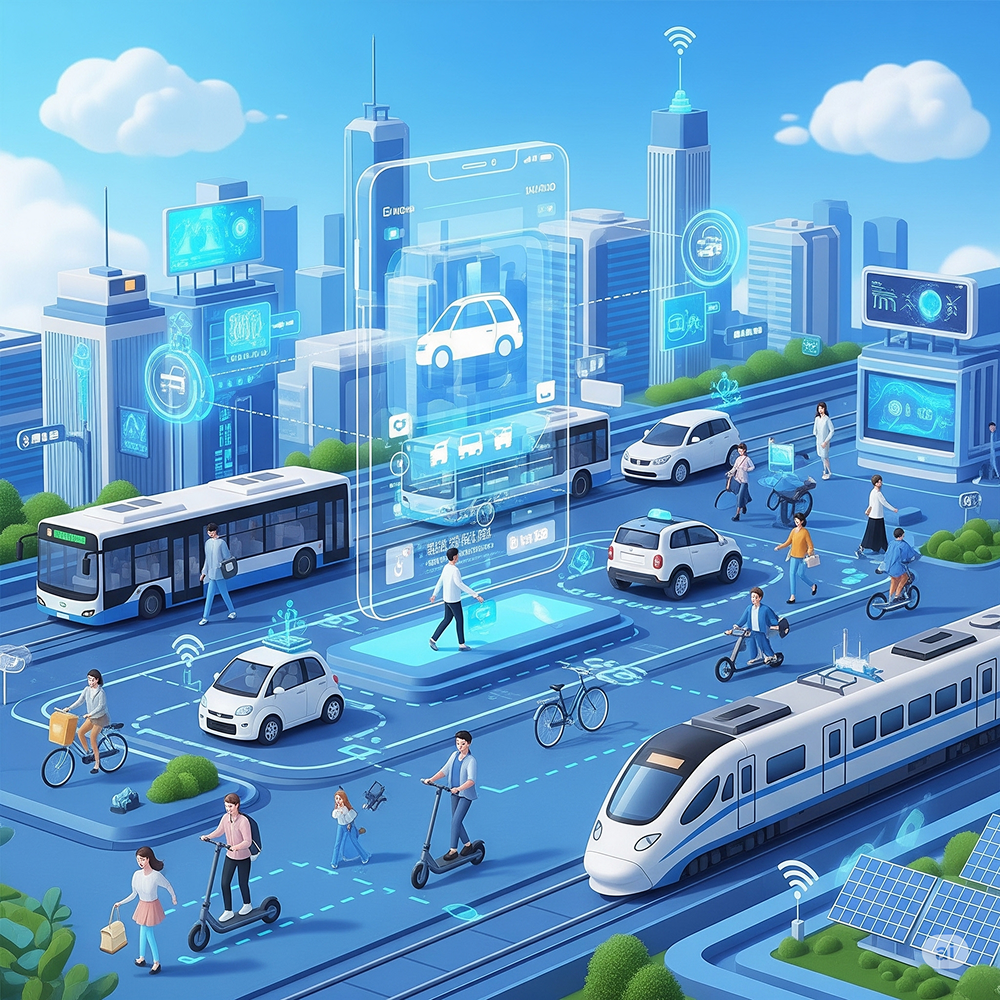The Future of Transportation: Mobility as a Service (MaaS)

The way we move is on the cusp of a revolution. For decades, the private car has reigned supreme, defining our cities, our commutes, and even our lifestyles. But the challenges of congestion, pollution, and the sheer cost of car ownership are pushing us towards a new paradigm: Mobility as a Service (MaaS).
Imagine a world where getting from point A to point B isn't about owning a vehicle, but about accessing a seamless network of transportation options, all managed through a single, intuitive platform. That's the promise of MaaS.
What exactly is Mobility as a Service (MaaS)?
At its core, MaaS is about integrating various modes of transportation – from public transit (buses, trains, subways) and ride-hailing apps (like Uber and Lyft) to car-sharing, bike-sharing, and e-scooters – into a single, user-centric digital platform. This platform allows users to:
- Plan: Find the most efficient and convenient route, considering multiple modes.
- Book: Reserve and arrange their chosen transport. This often involves direct integration with services that previously required a dedicated taxi booking app or specific ride sharing app.
- Pay: Handle all payments for their journey through a unified system, often with flexible subscription models or pay-as-you-go options.
Think of it as the "Netflix of transportation," offering a personalized, on-demand experience that prioritizes convenience, cost-effectiveness, and sustainability. For businesses looking to enter this space, partnering with a skilled taxi booking app development company or a taxi app development company is crucial to create a robust and integrated platform. Many opt for white label taxi app development solutions or seek to build taxi app functionality that can compete with or even integrate popular services, potentially leveraging an Uber clone app or similar uber clone apps.
Why is MaaS the Future? The Benefits Unpacked

The shift towards MaaS brings a multitude of advantages for individuals, cities, and the environment:
For Users:
- Unparalleled Convenience:No more juggling multiple apps, tickets, or payment methods. A single platform streamlines the entire journey, whether it's for a quick taxi booking or a longer intermodal trip.
- Cost Savings:Reduced reliance on private car ownership means saving on fuel, insurance, maintenance, and parking. MaaS offers a range of affordable options and helps optimize routes to minimize expenses. This is particularly appealing when considering the alternatives of individual carpool app use versus a seamlessly integrated solution.
- Personalized Choices: Users can tailor their trips based on their preferences – fastest route, cheapest option, most eco-friendly, or a combination. The MaaS platform will present options from public transport to a taxi booking mobile app development service.
- Increased Accessibility:MaaS can significantly improve mobility for underserved populations, including the elderly, those with disabilities, and low-income households, by providing a comprehensive and accessible network of options, including various forms of ride hailing apps.
For Cities and the Environment:
- Reduced Congestion:By encouraging the use of shared and public transport, MaaS can significantly decrease the number of private vehicles on the road, alleviating traffic bottlenecks. This includes optimizing the dispatch of vehicles from taxi app development services to reduce empty mileage. Studies suggest MaaS can reduce congestion by up to 20%.
- Lower Emissions and Improved Air Quality: Fewer cars translate directly to reduced CO2 emissions and other pollutants, leading to cleaner air and a healthier urban environment. Integrating electric vehicles from taxi application development into MaaS further amplifies these benefits. Some studies indicate a potential reduction of CO2 emissions by as much as 15-50% in urban areas.
- Optimized Infrastructure Utilization: Cities can make better use of existing public transport networks and reduce the need for extensive new road or parking infrastructure.
- Enhanced Urban Planning:Data generated by MaaS platforms provides invaluable insights into travel patterns, allowing city planners to make data-driven decisions for better infrastructure development, public transport routing, and land use. This can lead to repurposing land currently dedicated to parking for green spaces, housing, or commercial development.
- Economic Opportunities:MaaS fosters innovation, creating new business models and job opportunities in the smart mobility sector, including for companies specializing in taxi app development and providing readymade taxi app solutions.
Navigating the Road Ahead: Challenges to Implementation

While the vision of MaaS is compelling, its widespread adoption faces several hurdles:
- Stakeholder Collaboration:Integrating diverse transport providers – public and private, large and small – into a unified system requires significant cooperation, data sharing agreements, and aligned commercial interests. This is often the "Achilles' heel" for many MaaS projects, as it involves bringing together traditional taxi services with modern ride hailing apps and public transit.
- Technical Integration and Data Standards: Ensuring seamless interoperability between different systems, handling real-time data flow, and establishing common technical and financial standards are complex challenges. This is where the expertise of a taxi app development company that understands API integrations and data harmonization is vital.
- Regulatory Frameworks: Existing transportation regulations may not be equipped to handle the complexities of MaaS, necessitating new policies that encourage innovation while ensuring fair competition and consumer protection for all integrated services, from a traditional taxi app development to new ride sharing apps.
- User Adoption and Behavioral Change: Shifting deeply ingrained habits of private car ownership to a MaaS model requires public awareness campaigns, incentives, and a truly superior user experience to overcome inertia. The platform needs to be as intuitive as popular uber taxi apps to encourage seamless transitions.
- Data Privacy and Security:The collection and sharing of vast amounts of user data raise concerns about privacy and security, requiring robust data governance frameworks.
The Future Landscape of MaaS: Trends to Watch

Despite the challenges, the momentum for MaaS is undeniable. Several key trends are shaping its evolution:
- Advanced Technologies: The integration of Artificial Intelligence (AI) and Machine Learning (ML) will enable more sophisticated route optimization, demand forecasting, and personalized recommendations, enhancing the capabilities of any taxi booking mobile app development within the MaaS ecosystem.
- Micromobility Growth The proliferation of e-scooters, e-bikes, and other micromobility options will continue to play a crucial role in addressing first and last-mile connectivity within MaaS platforms.
- Autonomous Vehicles and Electrification: As autonomous vehicles and electric fleets become more prevalent, they will seamlessly integrate into MaaS ecosystems, offering even greater efficiency and sustainability. This will open new avenues for taxi app development services to incorporate these advanced fleets.
- Expanding Reach: MaaS is poised to move beyond megacities, reaching smaller urban centers and even semi-urban regions as demand for flexible transport solutions grows. The market for a readymade taxi app or solutions to create taxi app platforms for specific regional needs will expand.
- Stronger Partnerships: Increased collaboration between governments, public transport authorities, private operators, and tech companies, including specialized taxi booking app development companies, will be vital for scaling MaaS initiatives.
- Subscription Models and Flexible Pricing: Expect to see increasingly sophisticated subscription packages tailored to individual needs, alongside dynamic pricing models that adapt to demand and supply, much like the flexible models seen in leading ride-hailing apps.
- White Label Solutions: For businesses and even smaller municipalities looking to rapidly implement MaaS solutions, white label taxi app development offers a fast and cost-effective entry point. These pre-built and customizable platforms allow for quick deployment, helping to build taxi app capabilities without starting from scratch. This is particularly relevant for those wanting to offer a service that feels like their own app like Ola or Uber without the extensive development time.
MaaS and Urban Planning: A Symbiotic Relationship
MaaS is not just a transportation solution; it's a powerful tool for transforming urban environments. By reducing parking demand, promoting active travel (walking and cycling), and optimizing public transport, MaaS can directly influence urban design. It encourages a shift towards more compact, connected, and livable cities, freeing up valuable space for community development and green infrastructure. City planners can leverage MaaS data to make informed decisions about land use, infrastructure investments, and overall urban resilience, working hand-in-hand with the data insights provided by integrated ride hailing apps and taxi app development services.
Conclusion
Mobility as a Service represents a fundamental shift in how we perceive and utilize transportation. It offers a compelling vision of a future where journeys are seamless, sustainable, and truly user-centric. While the path to widespread MaaS adoption is not without its complexities, the immense benefits for individuals, cities, and the planet make it an imperative. As technology continues to advance and collaboration strengthens, and as the expertise of a taxi booking app development company becomes more pivotal in integrating diverse services, MaaS is set to redefine urban mobility, creating more efficient, equitable, and livable cities for generations to come. The future of transportation isn't just about moving, it's about moving smarter, together, with every taxi booking app development, ride hailing app, and carpool app playing a role in this integrated ecosystem.
